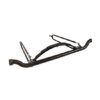Okay all,,, I know it's Christmas which I am very thankful for,,, no family home so I jumped online and found this post.
Wow this is a good one,,, this part is coming up quickly on my build,,,, I have several questions that need clarification from what I've read,,,
What is Ackermann,,, is there a post about it?
So when you attach the radius rods to the axle mounts ( mine are same as used on a 4 bar setup not welded on) (I have an I-Beam axle),,, then to the frame and finally the spring to the perch,,, there should be no binding or bending occurring,,,, right??? If so I'm in big trouble

When I welded the front spring perch mount on, I set it at 7 degrees with the frame level to the ground. Now that it's on the floor and has most of the weight on it,,, with a mag level,,, it's resting at about 3 degrees. Is that okay???
Lastly,,, looking at the long distance between the center line of the tire to the center line of the spindle on the T that started this post,,, I would think that it would be a major contributing factor to the problem your having. Just my eyeball engineering here. The distance from pivot to where the work is happening should be as close as possible IMHO. I think on the Dodge Magnum they designed the setup to have the centerline of the tire almost on the same plane as the spindle.
Thanks for all the advise. KIS4S please,
GM










